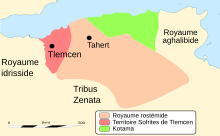Rustamids
The rustamids ( Arabic رستميون, DMG Rustamiyūn ) were a Ibadite dynasty in Tahert in western Algeria in the period 778-909.
Founding history
The 740 broken by Berbers supported uprising of Maysara was 742 by the Arab troops of the Umayyad been deposited. The Berbers were mostly for Ibadiyya, one during this time Kharijite expression of Islam , a convert. Their opposition to the supremacy of the Arabs persisted even after the failed revolt. However, the Arabs continued their expansion, even after the fall of the Umayyads and the transition of the caliphate to the Abbasids . They conquered 758 under Abu l-Chattab al-Maafiri Ifrīqiya and Kairuan , with the Persian Ibn Rustam as governor in Kairuan (758-761). After the victory of the Abbasid troops (761) Ibn Rustam fled to the Zanata in western Algeria.
After a renewed uprising of the Kharijites under Ibn Rustam, Abu Quna and the Malzūza -Berber Abū Ḥātim al-Malzūzī before Kairuan failed in 772, Ibn Rustam withdrew to central Algeria and founded the emirate of the Rustamids in Tahert. Attempts to expand the empire towards its neighbors failed because of the military weakness of the Rustamids, who were always dependent on the help of the surrounding Berber tribes and foreign aid. In particular, through the alliance with the Miknasa of Sidschilmasa and the Spanish Umayyads of the Emirate of Cordoba , the empire was able to assert itself against the neighborhood of the Idrisids and Aghlabids . In 787 peace was made with the Abbasids .
Heyday
Tahert quickly developed into the religious and cultural center of the Kharijites in the Maghreb . Many Kharijites immigrated to Tahert from the Middle East, where they were persecuted. Economically, the empire achieved some prosperity through the caravan trade and the export of grain to Andalusia . Politically, however, the Imamate was endangered and unstable due to the fickle loyalty of the allied Berber tribes and the frequent quarrels about the suitable ruler, which are typical of Karijite movements. As a result, its boundaries were subject to permanent change and the Rustamidenimamat never assumed a uniform form for a long time. After the death of Ibn Rustam in 788 there was a schism , as a result of which the Nukkar , a main branch of the Ibdadites that has existed up to the present day, split off from the Rustamids.
Downfall
In 909 the imamate of the Rustamids was conquered by the Fatimids . The surviving Kharijites withdrew to Sedrata, near today's Wargla, in the Sahara . As the burial place of the last Imam of Tahert, Sandrata developed into an important pilgrimage center for the Ibadites. However, Sandrata was subjugated by the Hammadids as early as 1077 , which is why the Ibadites withdrew to the area of Wadi M'zab (see: Mozabites ).
List of the Rustamid rulers of Tahert
- 'Abd al-Rahman ibn Rustam (778-788)
- 'Abd al-Wahhab ibn' Abd al-Rahman (788-824)
- Aflah ibn 'Abd al-Wahhab (824-872)
- Abu Bakr ibn Aflah (872-874)
- Abū l-Yaqzān Muhammad ibn Aflah (874-894)
- Yusuf ibn Muhammad (894-895) (first reign)
- Ya'qub ibn Aflah (895-899) (first reign)
- Yusuf ibn Muhammad (899-?) (Second reign)
- Ya'qub ibn Aflah (? –907) (second reign)
- Yaqzan ibn Muhammed (907-909)
See also
literature
- Clifford Edmund Bosworth: The New Islamic Dynasties. A Chronological and Genealogical Manual . 2nd Edition. Edinburgh University Press, Edinburgh 2004, ISBN 0-7486-2137-7 .
- Stephan Ronart, Nandy Ronart: Lexicon of the Arab World. A historical-political reference work. Artemis Verlag, Zurich et al. 1972, ISBN 3-7608-0138-2 .

